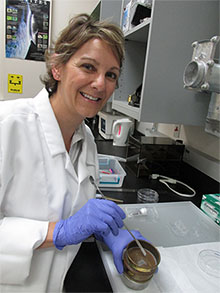Physics’ Zellner Is Always Looking
January 11, 2016

Nicolle Zellner still remembers those perfect Wisconsin nights when, as a kid, she’d look up to the sky and into the endless darkness full of possibility and uncertainty, and wonder what else was up there.
By Chuck Carlson
Nicolle Zellner still remembers those perfect Wisconsin nights when, as a kid, she’d look up to the sky and into the endless darkness full of possibility and uncertainty, and wonder what else was up there.
In many ways, she’s still doing it.
“We are still learning,” she said. “You get sucked into the excitement.”
There has always been excitement in the things Zellner can, and cannot, see. Whether it’s microscopic glass particles from impact craters on the moon or trying to understand a solar system that refuses to be understood, Zellner is always wondering what else is up there.
Maybe because of that curiosity, Zellner developed a love and an aptitude toward math and science that has stayed with her ever since.
Now in her 11th year as a professor in the Physics Department at Albion College, she has been drawn for years to the skies and what they have to say.
She earned her bachelor’s degree in physics from the University of Wisconsin-Madison and then proceeded to receive her master’s in physics and Ph.D. in the multidisciplinary field of astrobiology from Rensselaer Polytechnic Institute in New York.
And she’s not sure how much of that would have happened if the person she was looking for all those years ago as a young student hadn’t been out to lunch—literally.
“I decided late what I would major in in college,” she said. “So I called about the aerospace engineering program at Wisconsin, but the person I needed to talk to was out to lunch. So I called the astronomy department and one hour later I had a job at the campus telescope.”
And she’s been looking up ever since and focusing on one place in particular—the moon. For Zellner, our celestial cousin isn’t a gray, crater-pocked, desolate hunk of rock that, so far at least, is the only place human beings have set foot on.
To her, the moon remains an enigma that has yet to reveal even a fraction of its secrets.
“There are exciting things we can learn from the moon,” Zellner said.
And she plans to continue that study and, along the way, help make Albion a player in the study of the solar system.
This fall, Zellner received three grants from the National Science Foundation and NASA to explore what lunar glasses, created by meteor impacts, tell us about solar system processes.
The $198,000 grant from the NSF will allow her to travel at least twice to Curtin University in Perth, Australia, and the Australian National University in Canberra starting next winter.
In addition, Zellner will be part of new NASA-funded collaborations with colleagues at Purdue University and at Marshall Spaceflight Center in Huntsville, Alabama, where she’ll study meteor impact glasses on the moon recovered from the Apollo 16 moon mission.
Those glass beads can offer a glimpse back to the ancient past of the moon and, indeed, offer clues to just how the Earth was affected by comets or asteroids and, perhaps, what its future holds.
She has analyzed the ages of about 150 samples over the years, most from those later Apollo missions, but said more data are needed.
Still, the samples already on hand have made a difference in learning how the moon, the Earth and even the solar system are now being studied.
“What we thought we knew is changing,” she said. “The data are telling us something interesting was happening on the moon in terms of how many objects have hit it over time.”
Her studies, which have taken her to Europe and to Australia, and the fact that Josh Cassada, ’95, is a recently named NASA astronaut, have helped put Albion on the map in terms of physics and the exploration of space.
“I honestly think it does,” she said. “I don’t think Albion was even on the radar with NASA but this puts Albion’s name out there nationally.”
And for Zellner, just as she did as a kid in the Wisconsin countryside, it offers another opportunity to keep looking up.